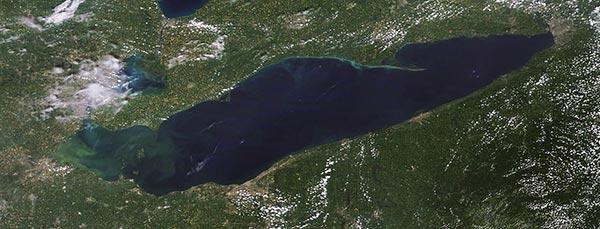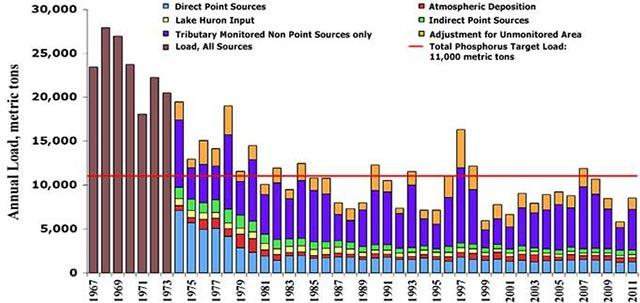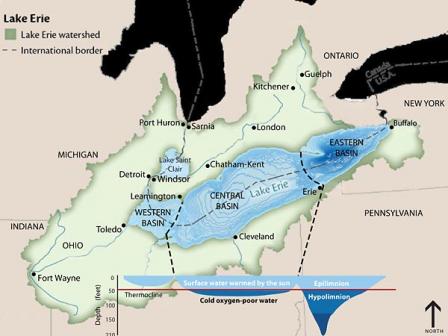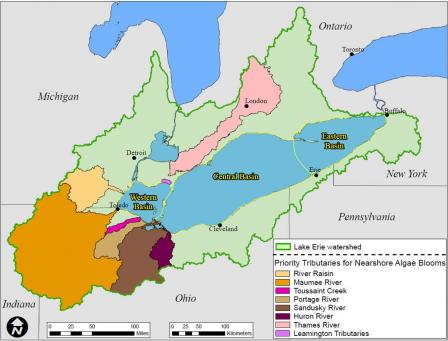Recommended Binational Phosphorus Targets
Recommended Binational Phosphorus Targets to Combat Lake Erie Algal Blooms
view this page as a printable fact sheet
 Satellite image of an algal bloom on Lake Erie, taken on August 4, 2014. Credit: NASA Worldview
Satellite image of an algal bloom on Lake Erie, taken on August 4, 2014. Credit: NASA Worldview
- What Is the Problem?
- Why Is Algal Growth Increasing?
- What Is the Desired Outcome?
- How Were the Recommended Targets Determined?
- What are the Recommended Phosphorus Reduction Targets?
- Why aren’t Phosphorus Concentration Objectives being Recommended?
- What are the Next Steps?
Algae occur naturally in freshwater systems. They are essential to the aquatic food web and healthy ecosystems. However, too much algae can lead to the development of algal blooms, which can be harmful to human health and the environment. Since the 1990s, Lake Erie has been experiencing increasing algal growth, resulting in increased impairment of water quality, as well as increased impairment of the use and enjoyment of the tremendous natural resource that is Lake Erie.
To combat this growing threat, the Governments of Canada and the United States are committed to working with others to manage phosphorus concentrations and loadings in Lake Erie as a means of reducing algal growth. This commitment is formalized in the 2012 Great Lakes Water Quality Agreement (GLWQA), which stipulates completion of revised binational phosphorus reduction targets for Lake Erie by February 2016. To learn more about the Agreement, visit http://binational.net. Exit
Working in collaboration, federal agencies, state and provincial governments, municipal and local governments, and many other partners convened a GLWQA Nutrients Annex Subcommittee Exit in 2013 to review the interim phosphorus targets for Lake Erie, last revised in 1983, and recommend revisions to those targets. Subject matter experts supported this effort through the development of a technical report.
This website summarizes the GLWQA Nutrients Annex Subcommittee recommendations.
| Lake Ecosystem Objectives Great Lakes Water Quality Agreement Annex 4, Section B |
Western Basin of Lake Erie | Central Basin of Lake Erie |
|---|---|---|
| Minimize the extent of hypoxic zones in the Waters of the Great Lakes associated with excessive phosphorus loading, with particular emphasis on Lake Erie | 40 percent reduction in total phosphorus entering the Western Basin and Central Basin of Lake Erie – from the United States and from Canada – to achieve 6000 MT Central Basin load | |
| Maintain algal species consistent with healthy aquatic ecosystems in the nearshore Waters of the Great Lakes | 40 percent reduction in spring total and soluble reactive phosphorus loads from the following watersheds where localized algae is a problem: | |
|
|
|
| Maintain cyanobacteria biomass at levels that do not produce concentrations of toxins that pose a threat to human or ecosystem health in the Waters of the Great Lakes | 40 percent reduction in spring total and soluble reactive phosphorus loads from the Maumee River (U.S.) | N/A |
What Is the Problem?
Toxic and nuisance algal bloom occurrences in Lake Erie have increased over the past decade. The blooms threaten drinking water quality, increase costs associated with treatment needs, and occasionally force closures of treatment plants. They clog industrial water intake systems, adversely impact commercial and recreational fishing activities and other recreational pursuits, and degrade fish and wildlife habitat and populations.
Excessive algal blooms in the 1960s and 1970s were a major driver for the signing of the first Agreement in 1972. In that first Agreement, the Governments of Canada and the U.S. agreed to reduce phosphorus loads to Lake Erie by more than 50 percent (from 29,000 to 14,600 metric tons per year). In the 1978 Agreement, the two countries agreed to a further reduction of phosphorus loads to Lake Erie to 11,000 metric tons per year. Regulation of phosphorus concentrations in detergents, investing in sewage treatment, and developing and implementing best management practices on agriculture lands successfully achieved those targets. With the achievement of phosphorus load targets, algal bloom development in Lake Erie decreased significantly throughout the 1980s. However, in the 1990s, despite ongoing efforts to limit phosphorus discharges to Lake Erie, toxic and nuisance algal blooms began increasing.
 Annual total phosphorus load to Lake Erie.
Annual total phosphorus load to Lake Erie.
From Scavia et al. 2014. Assessing and addressing the re-eutrophication of Lake Erie: Central basin hypoxia. Exit Journal of Great Lakes Research 40: 226-246.
- algal toxins,
- the size of the low-oxygen (hypoxic) area that is created when algae die and decompose,
- and the presence of Cladophora.
In 2011, concentrations of the algal toxin microcystin in the open waters of the Western Basin of Lake Erie were 50 times higher than the World Health Organization limit for safe body contact, and 1,200 times higher than the limit for safe drinking water. In August 2014, algal toxins forced closure of the Toledo, Ohio, drinking water treatment plant, and private water users on Pelee Island, Ontario, were warned not to bathe in or drink Lake Erie water. The incident affected more than 500,000 people.
Since the early 2000s, the hypoxic (low-oxygen) area in the Central Basin of Lake Erie has increased to about 4,500 km2, on average, with the largest hypoxic event of 8,800 km2 occurring in 2012. Hypoxic conditions can affect the growth and survival of fish species. In 2012, hypoxic conditions were responsible for tens of thousands of dead fish washing up on a 40 km stretch of shoreline between Erieau and Port Stanley, Ontario.
Cladophora is a filamentous green algae that grows on hard substrates in all of the Great Lakes. Beginning in the early 2000s, mats of Cladophora in the Eastern Basin of Lake Erie, have caused beach fouling, undesirable odors from decomposing Cladophora, clogged industrial intakes and degraded fish habitat.
The GLWQA Nutrients Annex Subcommittee has suggested that the Lake Erie algal problem can best be described in relation to the three main basins of the Lake:
The Western Basin is very shallow with an average depth of 7.4 meters (24 feet) and a maximum depth of 19 meters (62 feet). It is warm, and it receives most of the total phosphorus load because of the size of the Detroit and Maumee Rivers. Since 1994, the Western Basin has received 61 percent of the whole lake annual total phosphorus load, while the Central Basin and Eastern Basin received 28 percent and 11 percent, respectively. As a result, algal blooms dominated by the blue-green alga (cyanobacteria) Microcystis aeruginosa occur regularly, fouling shorelines during spring and summer. This species can form blooms that contain toxins (e.g., microcystin) dangerous to humans and wildlife.
The Central Basin is deeper with an average depth of 18.3 meters (60 feet) and a maximum depth of 25 meters (82 feet). Here the excess phosphorus contributes to hypoxic conditions (low-oxygen) in the cold bottom layer of the Lake (the hypolimnion) when algae die and decompose. The biological activity uses up the oxygen during the summer, leaving little to none for the aquatic community which suffocates or moves elsewhere, creating Lake Erie’s “Dead Zone.”
The Eastern Basin is the deepest of the three basins with an average depth of 24 meters (80 feet) and a maximum depth of 64 meters (210 feet). Here, the excess phosphorus contributes to the excessive growth of Cladophora. Cladophora isn’t toxic, but it is a nuisance and may contribute to human health problems. Beyond clogging industrial water intakes and degrading fish habitat, rotting mats of Cladophora on beaches encourage the growth of bacteria and are a factor in beach closures. The presence of Cladophora may create an environment conducive to the development of botulism, which results in bird and fish deaths.
 Lake Erie Basin. Credit: Environment Canada.
Lake Erie Basin. Credit: Environment Canada.
Why Is Algal Growth Increasing?
A number of factors affect algal growth, including climatic conditions and nutrient availability. Increasing temperatures in recent years is creating longer growing seasons for algae and contributing to increased algal growth. More frequent high-intensity spring storms are resulting in nutrients being washed off of urban and agricultural lands, as well as causing bypasses and overflows from sewage treatment facilities, which also contain nutrients. Spring nutrient loads are an important factor affecting algal growth.
Overall, monitoring has shown that despite significant year-to-year variation in loads, the total annual amount of phosphorus entering the Lake has been relatively stable over the past 15 years. However, there has been a significant increase in the proportion of the phosphorus load to Lake Erie that is in dissolved, as opposed to particulate, form. Dissolved phosphorus is more easily taken up by algae and contributes to increased algal growth. The reason for the increase in the proportion of phosphorus in dissolved form is not fully understood.
Zebra and Quagga mussels, both aquatic invasive species, have increased water clarity and changed nutrient cycling in Lake Erie, resulting in higher levels of algal growth, particularly close to the shore.
So why is Lake Erie experiencing more algal growth than the other Great Lakes? The answer is that, as the smallest of the Great Lakes by volume, and the shallowest, Lake Erie waters are the warmest and most biologically productive. Drainage basin characteristics also play a role. All of the Great Lakes experience issues associated with algae. The governments of Canada and the U.S. have committed to the review of phosphorus targets for all Great Lakes through the 2012 GLWQA. The experience garnered in reviewing Lake Erie targets will inform these reviews. Importantly, experts agree that, while many factors contribute to algal growth, controlling phosphorus concentrations and loads is the best way to reduce algal growth in the Great Lakes.
What Is the Desired Outcome?
Eliminating algae entirely is not the goal. Too little algal growth would not support a healthy aquatic ecosystem. The goal is to identify and achieve the right level and type of algal growth to support a healthy and productive Lake Erie ecosystem.
The Agreement provides guidance in relation to what constitutes a healthy and productive ecosystem from an algal production perspective. It does this in the form of the following six Lake Ecosystem Objectives.
- Minimize the extent of hypoxic zones associated with excessive phosphorus.
- Maintain the levels of algae below the level constituting a nuisance condition.
- Maintain algal species consistent with healthy aquatic ecosystems in the nearshore waters of the Great Lakes.
- Maintain cyanobacteria at levels that do not produce concentrations of toxins that pose a threat to human or ecosystem health in the waters of the Great Lakes.
- Maintain an oligotrophic state, relative algal biomass, and algal species consistent with healthy aquatic ecosystems, in the open waters of Lakes Superior, Michigan, Huron and Ontario.
- Maintain mesotrophic conditions in the open waters of the western and central basins of Lake Erie, and oligotrophic conditions in the eastern basin of Lake Erie.
How Were the Recommended Targets Determined?
The GLWQA Nutrients Annex Subcommittee studied information on algal patterns and species, lake circulation, and sources and loadings of phosphorus.
First, the group decided to align the relevant Lake Ecosystem Objectives to each of the three main basins of Lake Erie.
In the Western Basin, where blue-green algae (cyanobacteria) is the problem, the GLWQA Nutrients Annex Subcommittee determined that the focus should be on Lake Ecosystem Objective #4 (“Maintain cyanobacteria at levels that do not produce concentrations of toxins that pose a threat to human or ecosystem health in the waters of the Great Lakes”). Having reviewed the available data, the GLWQA Nutrients Annex Subcommittee proposed that in order to reasonably achieve this Objective in the Western Basin, efforts should be directed toward achieving conditions similar to those experienced in 2012, in nine out of 10 years.
Why 2012?
In 2012, the amount of cyanobacteria present in the Western Basin was considered to be a mild bloom; no significant impacts were noted, with the exception of some bloom conditions in inner Maumee Bay. Therefore, a reasonable threshold to limit the cyanobacteria metrics would be at a level below those seen in 2012.
Why Nine Years Out of 10?
In a year with extremely wet conditions in the spring (i.e. heavy rainfall) there will likely be substantial algal blooms despite phosphorous reduction efforts. In consideration of this, the work group proposed meeting the 2012 thresholds for algal blooms, on average, nine years out of 10.
In the Central Basin, where hypoxia is the problem, the GLWQA Nutrients Annex Subcommittee determined that the focus should be on Lake Ecosystem Objective #1 (“Minimize the extent of hypoxic zones associated with excessive phosphorus”). The GLWQA Nutrients Annex Subcommittee proposed that in order to reasonably achieve this Objective in the Central Basin, efforts should be directed toward achieving an average late summer (i.e. August to September) hypolimnetic (cold bottom layer) dissolved oxygen concentration in the Central Basin of Lake Erie of 2.0 mg/l or higher.
In the Eastern Basin, where Cladophora is the problem, the GLWQA Nutrients Annex Subcommittee determined that the focus should be on Lake Ecosystem Objective #2 (“Maintain the levels of algae below the level constituting a nuisance condition”). Having reviewed the available science and modeling, the GLWQA Nutrients Annex Subcommittee proposed that in order to reasonably achieve this Objective in the Eastern Basin, efforts should be directed toward achieving Cladophora biomass of less than 50g/m2.
In certain nearshore areas, where localized cyanobacteria blooms are the problem, the GLWQA Nutrients Annex Subcommittee focused on Lake Ecosystem Objective #3 (“Maintain algal species consistent with healthy aquatic ecosystems in the nearshore waters of the Great Lakes”). Having reviewed satellite imagery and other available data, the GLWQA Nutrients Annex Subcommittee proposed that in order to reasonably achieve this Objective in certain nearshore areas, efforts should be directed toward reducing nearshore cyanobacteria blooms.
With the relevant Lake Ecosystem Objectives identified and quantified, the GLWQA Nutrients Annex Subcommittee next identified the level of phosphorus reduction required to achieve the desired outcomes.
Modeling experts from the United States and Canada used nine different computer simulation models to correlate changes in phosphorus levels with levels of algal growth. By comparing and contrasting the results of these models, the GLWQA Nutrients Annex Subcommittee was able to arrive at phosphorus load reduction targets, calculated using 2008 data. 2008 was selected due to the quality of the data available for that year and because conditions in Lake Erie in 2008 are considered representative of an “average” year.
What are the Recommended Phosphorus Reduction Targets?
Western Basin
Modeling showed that spring loading of phosphorus from the Maumee River is the determining factor in the production of cyanobacteria in the open waters of the Western Basin of Lake Erie. The GLWQA Nutrients Annex Subcommittee found that to achieve 2012 conditions in the Western Basin in nine out of 10 years, there should be a reduction of 40 percent in spring loads of both total and dissolved phosphorus from the Maumee River. A 40 percent reduction to the Maumee equates to a target spring load of 860 metric tons per year of total phosphorus and 186 metric tons per year of soluble reactive phosphorus under high spring discharge conditions. The GLWQA Nutrients Annex Subcommittee has defined spring as the period between March 1 and July 31 each year.
Central Basin
Modeling showed that phosphorus concentrations in the Central Basin of Lake Erie are the result of loadings from sources discharging to both the Western Basin, including those along the Huron-Erie corridor, and the Central Basin. To achieve a minimum concentration of dissolved oxygen of 2 mg/l in the bottom waters of the Central Basin, there should be a reduction in the load of total annual phosphorus to the Western and Central Basins to 6,000 metric tons per year. This is a 40 percent reduction from the 2008 load.
Eastern Basin
For the Eastern Basin, the work group has not recommended a target to address nuisance algae (Cladophora) at this time. Additional science is required to link phosphorus loadings to changes in algal production prior to recommending phosphorus reduction targets for this area of the Lake. Nonetheless, it is important to note the targets that have been recommended for the Western and Central Basins work in concert, not in isolation. Because all tributaries to Lake Erie, including the Detroit River and the Huron-Erie Corridor, contribute phosphorus loads to the Eastern Basin, the reductions needed to address algal blooms and hypoxia will lower phosphorus concentrations in the Eastern Basin as well. This will help address nuisance algal issues in the Eastern Basin, while maintaining enough nutrients to support the fisheries.
Nearshore Waters
In some nearshore areas, including river mouths and embayments, phosphorus loads from the watershed contribute to localized blooms of cyanobacteria. Reducing spring total and soluble reactive phosphorus loadings in these watersheds by 40 percent is expected to reduce localized blooms of cyanobacteria in those areas. The working group has identified the following watersheds where localized cyanobacteria blooms are a concern: in Canada, the Thames River and Leamington area watersheds; in the U.S., the Maumee River, River Raisin, Portage River, Toussaint Creek, Sandusky River and Huron River watersheds. These watersheds are different from each other; as such the 40 percent reduction should be considered as a starting point. As programs are implemented, and research and monitoring efforts increase knowledge and understanding of phosphorus movement in these tributaries and the nearshore, reductions less than or greater than 40 percent may be required in each of these watersheds to resolve the associated nearshore cyanobacteria blooms.
 Map of Lake Erie Priority Watersheds. Created by U.S. EPA.
Map of Lake Erie Priority Watersheds. Created by U.S. EPA.
Why aren’t Phosphorus Concentration Objectives being Recommended?
The GLWQA Nutrients Annex Subcommittee has focused its recommendations on phosphorus loading reductions, not on phosphorus concentrations. Phosphorus concentration objectives were established in the past for the Great Lakes. However, the GLWQA Nutrients Annex Subcommittee found that phosphorus concentrations in the nearshore and open waters vary considerably over space and time, making them very difficult to track in a meaningful way through monitoring programs.
As a consequence, the GLWQA Nutrients Annex Subcommittee is recommending that phosphorus concentration objectives not be established for Lake Erie at this time. However, the GLWQA Nutrients Annex Subcommittee has estimated the phosphorus concentrations expected to result from the recommended phosphorus load reductions:
|
Basin |
Interim Objectives Great Lakes Water Quality Agreement |
Expected Outcome from Implementation of Proposed Load Reduction Targets |
|---|---|---|
| Lake Erie (Western Basin) |
15 |
12 |
| Lake Erie (Central Basin) |
10 |
6 |
| Lake Erie (Eastern Basin) |
10 |
6 |
What are the Next Steps?
U.S. Environmental Protection Agency (EPA) will be soliciting input on the recommendations of the GLWQA Nutrients Annex Subcommittee. Following consideration of input received, Environment Canada and the EPA will finalize targets in February 2016.
